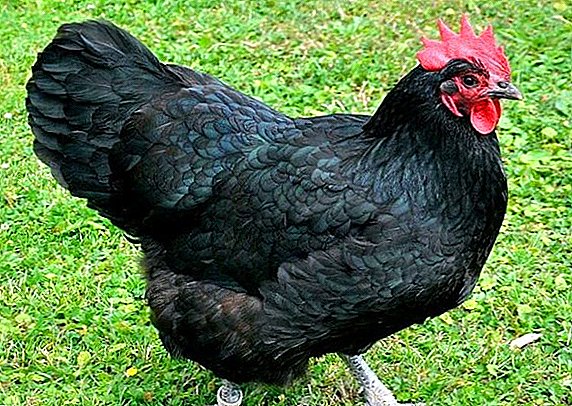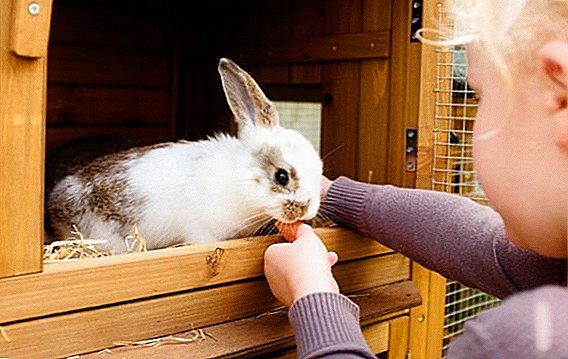 Dirty cells are the main cause of local diseases and epidemics in rabbits.
Dirty cells are the main cause of local diseases and epidemics in rabbits.
Pathogenic microflora progresses even with regular housekeeping eared.
How to save livestock from deaths, what to disinfect the abode of the wards and how often it should be done - we will tell about this later in the article.
Why and when should be carried out disinfection of rabbit cells
Getting rid of microbes living in rabbit cages is not so easy. They are not sensitive to high and low temperatures, quickly adapt to a chemical poisonous environment and are distinguished by high vital activity.  For a long time, the infection can multiply in the litter, on the walls and the floor of the cage, in feeders and drinkers, in the harvesting equipment. Regular cleaning of the premises helps to eliminate only 40 percent of the pathogenic bacteria, but in hard-to-reach places it still remains damp and dirt, which contributes to the development of infection.
For a long time, the infection can multiply in the litter, on the walls and the floor of the cage, in feeders and drinkers, in the harvesting equipment. Regular cleaning of the premises helps to eliminate only 40 percent of the pathogenic bacteria, but in hard-to-reach places it still remains damp and dirt, which contributes to the development of infection.
Later, when diseases begin to develop in the wards, even a correctly made diagnosis and timely treatment will not give the expected result until the cell is completely disinfected, as well as all the tools and equipment involved.
Important! After recorded cases of salmonellosis in rabbits, it is recommended to use as a disinfector: hot 2.5% sodium solution, formaldehyde 2% solution or 20% suspension of slaked lime.
According to experts, it is necessary to carry out disinfection measures every six months, regardless of the production scale of the rabbit breeding. Usually, such prevention is planned in the fall or spring, but in case of emergency, unscheduled treatments are possible.
Mandatory disinfection of rabbit cells:
- before transplanting young animals to adults;
- before okolom;
- after illness.

Decontamination methods
Since bacteria and viruses that threaten rabbits are highly viable, they are controlled by radical means.
Today the most effective of them are:
- Chemical processing - consists in the use of potent antiseptics when washing the internal and external surfaces of the cleaned and dried rabbit housing. After that, rinse with clean water and dry the cells.
- Chemical spray disinfection spray - the technology is very close to the previous one, it is characterized by minimal contact of hands with hazardous substances.
- Burning - implemented using a blowtorch or a gas torch and is highly effective.
- Automatic cleaning car wash "Kärcher".
- Disinfection with a building dryer.
Important! For treatment against staphylococcal infection, formaldehyde (4%), chloramine (2%), and dump (8%) are used.
Each of these methods helps to eliminate the pathogenic environment, but does not guarantee one hundred percent safety for the eared ones. Therefore, experienced breeders advise to approach the solution of the problem in a comprehensive manner, by alternately applying several variations of disinfection.  The most successful of them, according to the breeders, is a combination of roasting and chlorination.
The most successful of them, according to the breeders, is a combination of roasting and chlorination.
Disinfectants
Modern manufacturers of various "chemistry" significantly simplified the breeder care for eared pets. In any store you can find the widest range of special disinfectors.
When breeding rabbits, it is important for you to know that rabbits are prone to diseases such as coccidiosis, pasteurellosis, listeriosis, myxomatosis, encephalosis, rhinitis, diarrhea, VGBK, versicolor, sores in the ears and eyes.
Here is a list of the most popular ones:
- bleaching powder - used in the form of a 10% solution, after which it is necessary to wait 30 minutes and rinse thoroughly;
- formaldehyde - recommended for use 2-% solution, it is applied by spraying (at the rate of 10 milliliters per cubic meter) for 25-30 minutes, then rinse with a hose;
- soda ash - 2% of the substance is dissolved in hot water and with the help of a sponge they process the cage, drinkers, feeding troughs, wash it off after half an hour;
- "White" - the working solution is prepared in a ratio of 1:10, after which the spray rabbit is sprayed inside and outside the rabbit dwelling with the help of a spray bottle; after an hour it is re-washed and dried;
- iodine - it is used in the form of a 5% solution; after one hour after application it can be washed off;
- ash liquor - recommended for neutralizing rabbit cells after chlorination, the solution is prepared by boiling water and wood ash combined in a ratio of 3: 1;
- formalin - spraying of surfaces is carried out with a 2% solution, after 25 minutes thereafter the chemical substance can be washed off;
- caustic soda - a 2% solution is used for disinfection, and to enhance its effect, 10% sodium chloride is added to it;
- slaked lime - used in the form of 10-% limestone suspension, after 3 hours, wash off;
- caspos - disinfection is carried out with a 3% solution, which is washed off after 3 hours.
 In addition, special disinfectants for rabbits can be bought in veterinary pharmacies. Such drugs are characterized by high efficiency, but unprofitable because of the high cost.
In addition, special disinfectants for rabbits can be bought in veterinary pharmacies. Such drugs are characterized by high efficiency, but unprofitable because of the high cost.Important! When temperatures are above zero, the disinfection solution can be cold, and when it is below zero, it can be hot.
According to the reviews of the rabbit producers, they proved themselves well:
- Virosan;
- Bromosept-50;
- Creolin;
- Virkon C;
- Virocid;
- Ecocide C;
- Glutex;
- Delegol;
- Diabak-Vet.
Preparation for the procedure
Disinfection by any means and means cannot be carried out in an uncleaned room. Before the procedure, thorough preparation is important, which consists not only in cleaning litter and bedding, but also in scrupulous washing of all surfaces of the rabbit house.  In order to provide high-quality cleaning, experts advise to act on the following algorithm:
In order to provide high-quality cleaning, experts advise to act on the following algorithm:
- First of all transplant animals into temporary housing structures.
- Remove all feeders, drinkers, and other removable parts from the cage.
- Using a dustpan, scraper, brush or broom, remove the old litter and its remnants from the floor. Cleaned manure should not be left on the ground under the cage. It is collected in a container or a dense trash bag for recycling.
- After that, carefully inspect the cell for its integrity. Various internal damage and damage is quite likely, because the tenants are rodents. If necessary, eliminate all structural defects.
- Rinse off all the dirt with a strong jet of hot water, paying maximum attention to dried residues of excrement and food. For hard-to-clean places, use a hard-fleeced brush or washcloth. Also process the outer surface of the cell.
- After that, rinse the design again using any detergent.
- Leave the cage for some time to dry. It is advisable to put it in a well-lit place during this period.
- Thoroughly clean and wash the feeders, drinkers, as well as all equipment involved in the maintenance of rabbits.
- While the cell is drying, clean in the room where it constantly stands. For this, it is important not only to sweep and remove the web, but also to wash the pathogenic microflora with a strong jet of hot water.
Did you know? Rabbit back left foot in many cultures of the world, including in Europe, North and South America, Africa and China, is revered as a talisman of happiness. Most likely, the belief in the magical power of this object dates back to 600 BC from the Celtic peoples who lived in the territory of European countries.
How to disinfect rabbit cells
After the cleaned rabbit house is completely dry, you can proceed to its disinfection. Let us consider in more detail the most popular processing methods. 
Cell firing with a blowtorch
Under the influence of fire, many pathogenic microbes, viruses, fungi and parasitic larvae die. Therefore, the use of a blowtorch is a favorite method of disinfection for most breeders. In addition, it does not require additional costs and resources, and after the procedure, the cell does not need to be re-washed and dried.
But only wooden structures with mesh elements can be subjected to such processing. Glass, ceramic, slate and plastic rabbits are not suitable for fire roasting.
Important! All ceramic, glass, metal and plastic objects that can not be subjected to firing, in the process should be carefully boiled before installation.
In order for decontamination to be of high quality, experienced breeders advise to follow the instructions below:
- Remove all flammable objects from the area where the rabbit's processing will be carried out and prepare a blowtorch for operation.
- Fiery jet walk on all the inner surfaces of the cell, so that a uniform fire lingers on the material for about 2 minutes.
- Do the same on the outside of the structure. As a result, the tree should turn a little brown.
- After disinfection, leave the cage to cool for a while. In the meantime, bake the wooden feeders.
- Similarly, disinfect with fire the room where the rabbit house resides. After that, put the cooled structure in it and equip with all the missing elements, fill the litter on the floor and return the eared home.
Rabbit cage disinfection: video
Disinfection of cells "Belize"
Chlorine-containing substances lead in popularity among all known antiseptics, due to their availability and effectiveness. Professionals advise to carry out all work with "Belize" in gloves, because the liquid is characterized by increased aggressiveness and can damage the skin.
Also, excessive evaporation can provoke serious intoxication and allergic reactions in the body. Therefore, before the start of processing, it will not be superfluous to take care of measures of your own protection.
Did you know? Rabbit eyes are placed in such a way that they can observe what is happening on the sides and back, without wrapping their heads.
Proper disinfection of rabbit "Belize" includes the following steps:
- First, prepare an antiseptic on the street by dissolving the entire bottle of "Whiteness" in a 10-liter bucket of warm water. Stir the liquid well.
- After that, pour the disinfector into the spray bottle and spray it on all the inner and outer surfaces of the previously washed and dried cell. Especially scrupulously handle slots and hard-to-reach places.
- All removable parts of the rabbitry, as well as the inventory used in its maintenance, are subject to similar processing.
- After completing the listed work, leave the construction for an hour.
- After the specified time, rinse "Whiteness" with a strong jet of hot water, and also use a washcloth. After all, contact with such chlorine-containing substances will end badly for a pet.
- Let the cage dry out, and in the meantime, spray the ceiling, walls and floor in the place where the rabbit housing is located. An hour later, go over the treated surfaces with water from a hose and let it dry.
- When the water in the cage, as well as in the room where it always stands, will not remain a trace, you can arrange all the objects in places and engage in the internal arrangement of the rabbit.

With the help of the car wash "Kärcher"
This portable cleaner is especially popular with modern farmers. The device is so versatile that it is difficult to imagine any cleaning in the household without it. Moreover, with the unit even the smallest slots in the rabbit cloister become accessible.
They are not cleaned due to high water consumption, but by a stream of hot steam. The disadvantage of such a wash is only one - the high cost, which starts from $ 500. But if you already have “Kärcher” in your household, then sin will not make it easier for you to care for the rabbit with it.
For quality disinfection, proceed as follows:
- Prepare the car wash for operation.
- Turn the device into a power outlet and carefully nozzle it over all surfaces of the cell. Pay special attention to the places of intersection of parts. Do not hurry. It is important that hot steam under high pressure gets into hard to reach places.
- Do a similar processing from the outside of the cage, as well as with items removed from it, inventory.
- Let the structure dry for an hour and air out after steam disinfection. Experts advise for this to put the building in a well-lit place.
- Now, by the same principle, sanitize the walls, ceiling and floor in the room where the rabbit house will be.
- When everything is dry, put the cage in place and equip it with feeders, drinkers, fill in the food and cover the floor with straw. Transplant to your home abode tenants.
 Cleaning rabbitrels is of particular importance for the safety of livestock.
Cleaning rabbitrels is of particular importance for the safety of livestock.Important! In the fight against pasteurellosis, one of these means is usually used: slaked lime (20%), formaldehyde solution (0.5%), chlorine solution (2%), hot xylonaph (2%).
Remember that it is better to prevent a problem than to deal with it later. As you can see, there are many ways to disinfect cells and not all of them require additional resources or financial costs. The main thing - do not be lazy and take care of the cleanliness of their wards.












